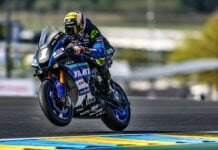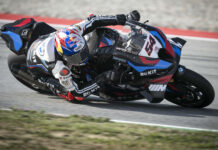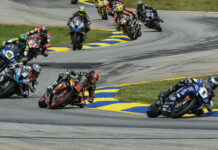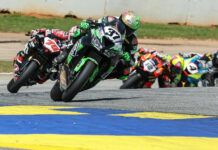From a press release issued by Aprilia:
Le Mans, France. Fourth round of the World Road Racing Championship
The Bugatti circuit was completed in 1965 in the area of the historic 24-Hour track, and became the venue for the first motorcycling competitions in the late 1960s. Then a veil was drawn and the World Road Racing Championship closed down, as from 1995, when major redevelopment work was carried out to ensure greater safety, for the circuit was not considered suitable for the greater power of modern bikes. After five years, these modifications were terminated and the World Championship made its grand return. The facility is now fantastic and can host 100,000 spectators: it has become the venue for the World Road Racing Championship, as well as the Formula 3000 FIA, the French touring championship and the GT championship.
The circuit is located 5 km south of the town of Le Mans, 200 km from Paris. It has some very special features: there are a number of corners the riders need to negotiate in first, with breakneck speeds and violent braking, followed by extraordinary accelerations which put the ability to deliver full power to the ground to the absolute test. A truly tough circuit to interpret and one that has, once again, undergone some modifications this year. This is why last year’s records will no longer provide a guideline for the first data to emerge from this weekend’s sessions.
The circuit: 4,180 metres – left curves: 4 – right curves: 9 – longest straight: 440 metres – maximum width: 13 metres.
2001 winners. 125 Class: Poggiali (ITA) Gilera – 250 Class: Katoh (JAP) Honda – 500 Class: Biaggi (ITA) Yamaha.
Circuit records. No previous comparable record, as the circuit has been modified this year.
Marco Melandri – 250cc Class – Aprilia RSW 250
After fracturing his left ankle after making contact in the Jerez race, which put him out of action in the Spanish Grand Prix, he has been examined a number of times by the doctors of the mobile clinic over the past few days. Dr Claudio Costa has kept a constant eye on Marco’s conditions, recommending the most suitable rehabilitation methods to put him back into top form for this weekend’s Le Mans. Last year, Marco performed brilliantly in the Friday sessions, and made third place on the podium in spite of a nasty fall on the Saturday which dislocated his shoulder. So once again we can look forward to a great show of determination from the Ravenna-born rider. His ankle is going to complicate matters over the next few days, but his absolute determination will let him ride out the problem.
“I’m not up to tip-top form yet, but I’ve done everything I can to recoup after the incident in Jerez. I’ve been working in the pool and on the training cycle without straining my ankle. I love the track: it’s changed slightly since last year, and I’m looking forward to seeing what they’ve done, as soon as I get to Le Mans. The problems are caused by the technical features of the circuit: there are first-gear curves and sixth-gear straights. Slamming on the brakes and frequent speed changes… My left ankle – the one I use for the gear change – will really be put to the test: it’s not that strong or flexible and I might have problems from beginning to end of the race. But I’m trusting in luck. I was angry and disappointed about the last race in Jerez: I didn’t gain a single point and all my work was in vain – but this will only help me get over the problem of my ankle. As far as the set-up of the bike is concerned, the drive unit and brakes are crucial if we’re to get what we need for this particular track. It shouldn’t be too difficult, though: last year we got everything right as early as Friday and I was going real fast right from the start.
REGIS LACONI – MotoGP – APRILIA RS3
Just the time it took to get back from Jerez to Italy, one day’s rest and then back again on the saddle for a new series of tests at Mugello. There is no let up in Régis Laconi’s programme. Last week, the Italian-French rider was out on the track in Tuscany with the Racing Department’s development team. Not even the bad weather put him off, and for two days he clocked up lap after lap to continue development of the RS Cube. Two important days of tests made it possible to try out new components and settings on the bike. And undoubtedly the opportunity to gain even greater confidence in the wet, thanks in part to the new Dunlop materials tested at Mugello. Régis is coming up to the key moment of the year: the “home” race – where he has just got to do well – even if only to keep his fans happy.
“The Mugello tests were really important, even though the weather was awful: we were able to try out the new products for the rain from Dunlop, and I must say I liked them. The tyres were great in the wet: they’d have made all the difference during the first race of the championship at Suzuka. Just to give an idea, we were 3 seconds faster than last year times, in the wet at Mugello, during the race. But we also had some other positive results on two bikes with different settings: the one we normally use at Mugello and another with a very different geometry. I can’t deny that I’ve got high hopes for the French Grand Prix: I’ll be returning to this track after a year away: I was in the Superbike with Aprilia. It certainly won’t be easy, for I’m under all the pressure of a “home” race. I’ll try to mitigate the tension and just work as though I were at any of the other championship races. I haven’t been over the new modifications to the track yet so I’ll just have to do my best to work them out as soon as possible. On the other hand, I do know the other characteristics of the circuit: lots of difficult technique, hard braking and full acceleration. Tight corners you’ve got to get out of as fast as possible. But I’m not worried: riding the Cube is a joy anywhere you go. It’ll be interesting to see how it responds when you ask it to deliver all the power it’s got when you come out of a corner.”
TECHNICAL BRIEFS:
The electronic heart of the RS3
(enclosed: 2 technical drawings)
RS3 : Innovative project, it has been called. However, not only the engine (derived from automotive technology); not only the starting and ignition mechanisms (all systems closely related to Formula1 technology); but also the electronic heart of the motorbike was born to introduce Aprilia and motorbike racing into the 3rd millennium.
The electronic system of the RS3 has been born from the vast experience Aprilia has gained during a 10 year period of continuous development of engine control systems and data acquisition. In fact all the engine management system, from the hardware to the software, has been designed, analysed and evaluated internally in the racing department. The system distinguishes itself for its simplicity: a unique Electronic Central Unit (ECU) manages the various electronic parts present on the motorbike; from the engine itself to the electronic gas (ride by wire: rbw); from all the sensors present to acquire data necessary for the development of the bike to the management of the electronic gear changing.
The extreme integration of the system has two main benefits: weight reduction, and a more efficient co-ordination between the different motorbike parts; since more and more functions present on the bike are servo-assisted and managed by electronic systems this second benefit is vital.
This simplicity, however, hides highly sophisticated softwares and management strategies that Aprilia has been developing in collaboration with various universities in the Venetian province. Neural networks and Fuzzy controllers are only a few of the systems used to manage the vehicle, united with motorbike dynamic models to optimise performance. It must be mentioned that sophisticated control systems present various problems; one just needs to think how many F1 cars remained immobile on the starting grid last season. However, Aprilia as a whole believes in this system, especially because the experience gained can be applied to production bikes.
Therefore, a unique system that manages the ignition, start-up mechanism, the rbw, the electronic gear changing and the clutch. Not to mention the monitoring system: the display allows the rider to continuously check the engines performance (RPM); various parameters; it alerts the rider if there are problems with the oil systems, water and pneumatic valves; it also shows the rider split and total lap times; and helps him during gear changes.

Furthermore, the system includes sensors to acquire parameters relative to the motorbikes dynamical behaviour round the track; pressures, temperatures, accelerations, torques and forces. Finally all the system it wired together using cables and connections highly integrated in the chassis and engine. All this to briefly explain the electronic system on the RS3.
122 Aprilia victories in the World Road Racing Championship
(data as of 14 May 2002)
125 cc. – 53 victories
1991: 1 – Gramigni (Brno)
1992: 3 – Gramigni (Shah Alam, Hungaroring); Casanova (Hockenheim).
1993: 1 – Waldmann (Jarama).
1994: 3 – Sakata (Eastern Creek; Jerez; Brno).
1995: 3 – Sakata (Donington; Brno), Tokudome (Rio).
1996: 10- Perugini (Shah Alam, Le Castellet, Donington), Tokudome (Sentul, Suzuka,
Nürburgring, Imola), Oettl (Mugello), Rossi (Brno), McCoy (Eastern Creek).
1997: 11 Rossi (Shah Alam, Jerez, Mugello, Le Castellet, Assen, Imola, Nürburgring, Rio,
Donington, Barcelona, Sentul).
1998: 4 – Sakata (Suzuka, Jerez, Le Castellet, Donington).
1999: 5 – Vincent (Barcelona), Locatelli (Le Castellet, Mugello), Scalvini (Valencia,
Welkom).
2000: 8 – Vincent (Welkom), Locatelli (Sepang, Mugello, Brno, Valencia, Motegi), Sanna
(Barcelona, Rio)
2001: 2 – Cecchinello (Barcelona), Sanna (Sachsenring)
2002: 2 – Vincent (Suzuka), Cecchinello (Jerez)
250 cc. – 69 victories
1987: 1 – Reggiani (Misano)
1991: 2 – Chili (Assen), Reggiani (Le Castellet)
1992: 6 – Reggiani (Jerez, Magny Cours), Chili (Hockenheim, Assen, Donington), Biaggi
(Kyalami).
1993: 3 – Ruggia (Donington, Misano), Reggiani (Brno).
1994: 6 – Biaggi (Eastern Creek, Shah Alam, Assen, Brno, Barcellona), Ruggia (Jerez).
1995: 8 – Biaggi (Shah Alam, Nürburgring, Mugello, Assen, Donington, Brno, Buenos
Aires, Barcelona).
1996: 9 – Biaggi (Shah Alam, Suzuka, Jerez, Mugello, Le Castellet, Donington, Brno,
Barcelona, Eastern Creek).
1997: 3 – Harada (Le Castellet, Assen, Nürburgring).
1998: 13- Harada (Johor Le Castellet, Jarama, Sachsenring, Brno), Capirossi (Jerez,
Donington), Lucchi (Mugello), Rossi (Assen, Imola, Barcelona, Phillip Island,
Buenos Aires).
1999: 9 – Rossi (Jerez, Mugello, Barcelona, Donington, Sachsenring, Brno, Phillip
Island, Welkom, Rio de Janeiro).
2000: 2 – Waldmann (Jerez, Donington).
2001: 5 – Harada (Mugello, Brno, Motegi), McWilliams (Assen), Melandri (Sachsenring).
2002: 2 – Melandri (Welkom), Nieto (Jerez)
Along with 122 GP successes and 15 world titles, Aprilia has also taken the podium 348 times. But that’s not all: 7 Superpoles and 8 victories in the Superbike championship (1 at Phillip Island, 2 at Misano, 1 at Valencia, and 1 at Laguna Seca in 2000, 2 at Valencia, and 1 at Imola in 2001). And 16 European road-racing titles (6 in 125, and 10 in 250).
But the 2 World Trial Championships (riders and manufacturers) won by Tommy Ahvala and Aprilia in 1992 should not be neglected either.






